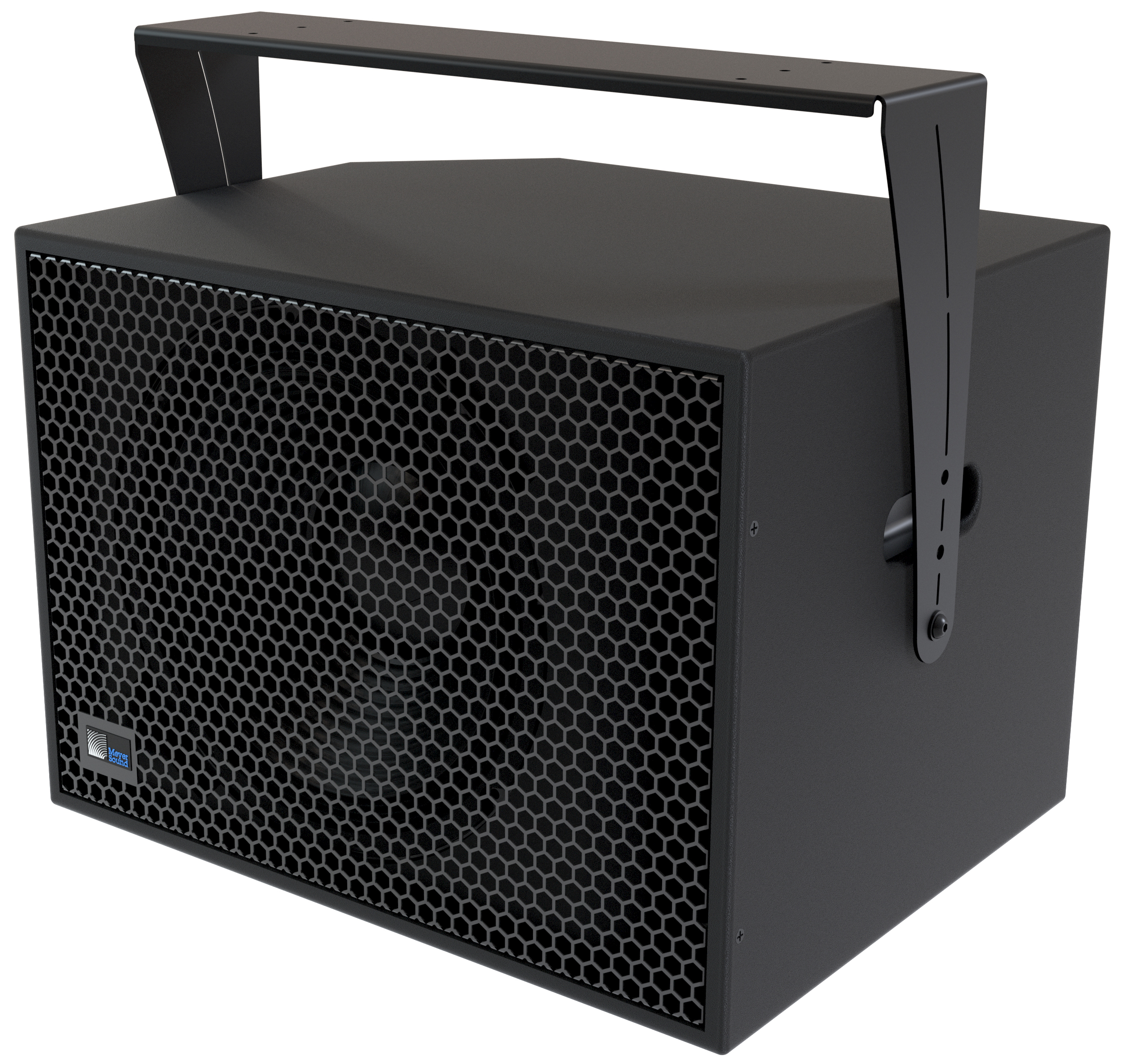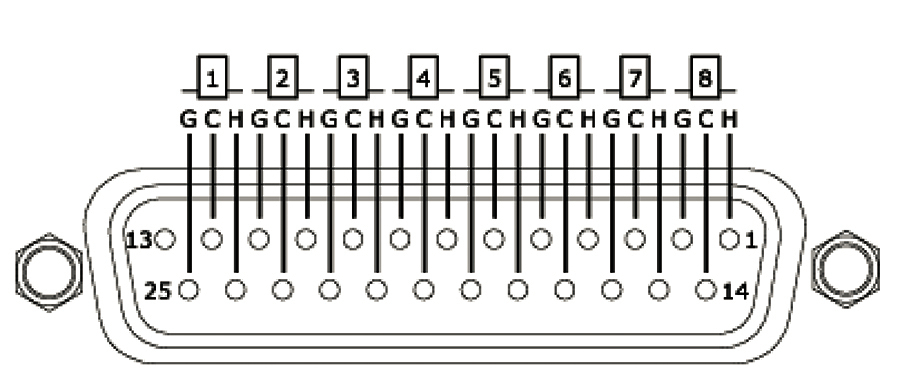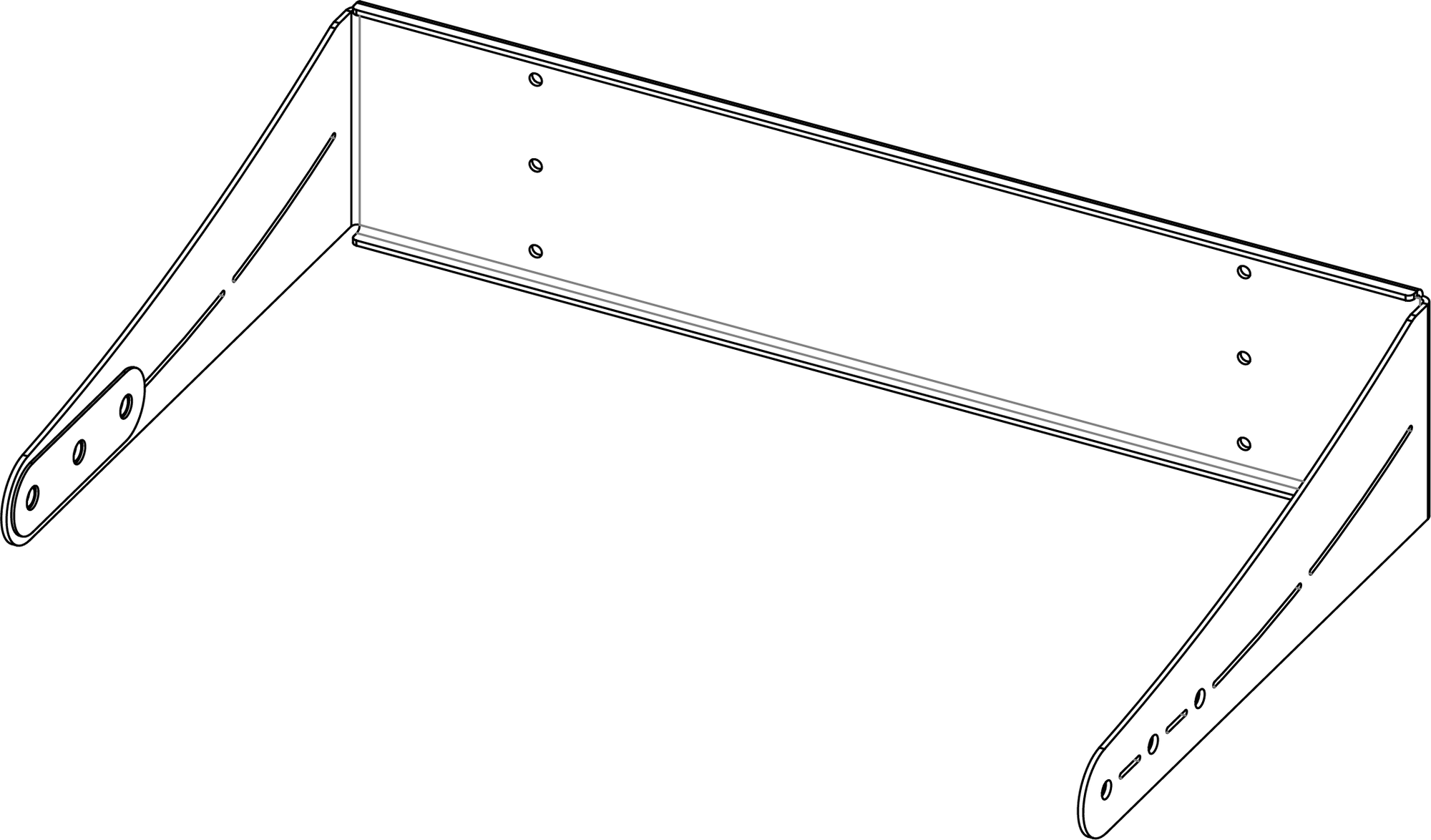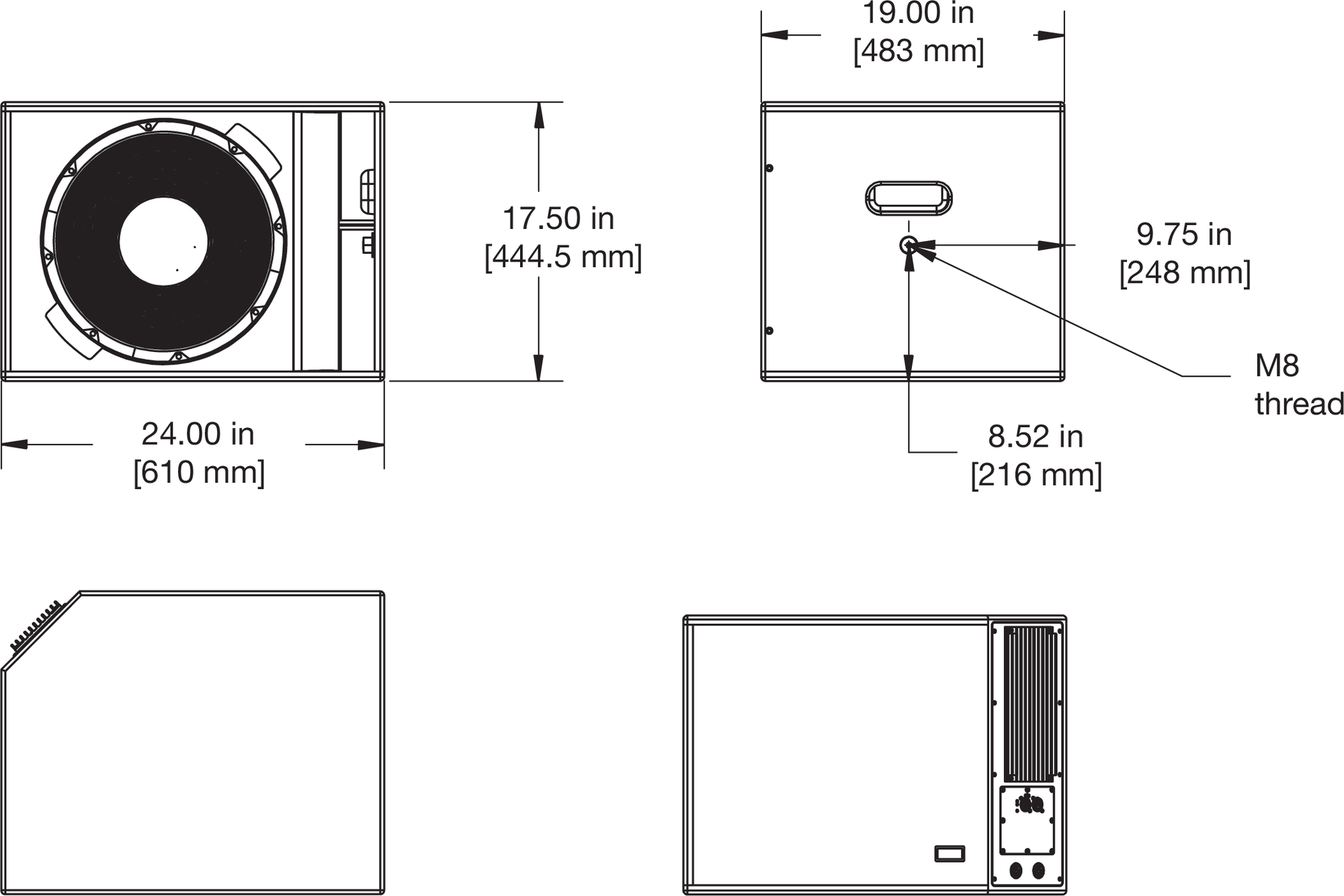Operating Instructions — Amie-Sub
Compact studio and cinema subwoofer
The Amie-Sub was specifically designed to be the perfect companion for Amie precision monitors—creating a complete system by extending the system frequency response down to 22 Hz with easy integration in multichannel configurations.

In addition, due to its performance and versatility, the Amie-Sub is equally suited to complement other Meyer
Sound loudspeakers, such as HMS-5, HMS-10, HMS-12, and HMS-15 (in immersive surround applications) or UltraSeries loudspeakers (for more general applications).
Extensive research and measurements resulted in the creation of Amie-Sub integration modules to produce consistent behavior across multiple configurations and environments. These optional integration modules enable the Amie-Sub to excel at working in any multichannel configuration, creating a perfectly balanced and easy-to-set-up system with up to seven Amie precision monitors.
The Amie-Sub has an operating frequency range of 22–160 Hz and a linear peak SPL of 124.5 dB with crest factor >11.5 dB (measured in half-space at 4 m and referred to 1 m using M-noise).
The Amie-Sub includes a single 15-inch, low distortion, long excursion cone driver. The bass reflex cabinet employs optimized port design for high efficiency and low port distortion. Its slanted connector panel, as shown in the figure below facilitates flush-mounting the cabinet against wall surfaces, reducing required installation depth to 19 inches including connectors.

Amie-Sub Slanted Connector Panel
Integrated Amplifier and Processing
A self-powered loudspeaker, the Amie-Sub cabinet houses an open-loop class D amplifier. The audio signal is processed with electronic crossover, correction filters for flat frequency and phase responses, and by driver protection circuitry. The built-in crossover accepts full-range signals which enables daisy-chain signal distribution and eliminates the need for external crossovers in smaller systems. The amplifier/processing package incorporates Meyer Sound’s Intelligent AC™ which auto-selects the correct operating voltage, suppresses high voltage transients, filters EMI and provides soft-start power-up.
The Amie-Sub cabinet comes standard with audio XLR and powerCON 20 input and looping output connectors.
The optional 2.1 integration module features 2 input channels using XLR connectors, while the optional 7.1 module features industry-standard multi-pin DB-25 and can be used in 5.1 or 7.1 configurations with third-party, high-quality, 8-channel DB-25 to XLR cables.
The integration modules feature bass management processing as well as a dedicated phase-matched .1 input for the LFE channel with selectable +10 dB boost to meet a variety of standards.
The Amie-Sub loudspeaker’s on-board amplifier is convection cooled.
Integrated Rigging Points
Meyer Sound constructs the Amie-Sub cabinet from premium birch plywood coated with a durable, slightly textured finish and includes a stamped-steel grille to protect the drivers. A grille frame with black cloth that mounts on top of the steel grille is optionally available, as shown in the first figure below.
The Amie-Sub comes standard with two 3/8-inch - 16 mounting points on each side for use with the optional MUB-Amie-Sub U-bracket to mount the subwoofer from ceilings, as shown in the second figure below.

Amie-Sub with Optional Black Cloth Grille Frame

Amie-Sub with MUB-Amie-Sub (ceiling mount)
Power Requirements
The Amie-Sub subwoofer combines advanced loudspeaker technology with equally advanced power capabilities. Understanding power distribution, voltage and current requirements, and electrical safety guidelines is critical for the safe operation of the device.
AC Power Distribution
All components in an audio system (self-powered loudspeakers, mixing consoles, and processors) must be properly connected to an AC power distribution system, ensuring that AC line polarity is preserved and that all grounding points are connected to a single node or common point using the same cable gauge (or larger) as the neutral and line cables.
Caution
Make sure the voltage received by the Amie-Sub loudspeaker remains within its 90–264 V AC operating range. In addition, the ground line must always be used for safety reasons and the line-to-ground voltage should never exceed 250 V AC (typically 120 V AC from line to ground).
Before applying AC power to any Meyer Sound self-powered loudspeaker, make sure that the voltage potential difference between the neutral and earth-ground lines is less than 5 V AC when using single-phase AC wiring.
Note
Improper grounding of connections between loudspeakers and the rest of the audio system may produce noise or hum, or cause serious damage to the input and output stages of the system’s electronic components.
120 V AC, 3-Phase Wye System (Single Line) Line-Neutral-Earth/Ground
The figure below illustrates a basic 120 V AC, 3-phase Wye distribution system with the loudspeaker load distributed across all three phases, with each loudspeaker connected to a single line and common neutral and earth/ground lines. This system delivers 120 V AC to each loudspeaker
 |
120 V AC, 3-Phase Wye System (Single Line to Loudspeakers)
120 V AC, 3-Phase Wye System (Two Lines) Line-Line-Earth/Ground
The figure below illustrates a 120 V AC, 3-phase Wye distribution system with each loudspeaker connected to two lines and a common earth/ground line. This configuration is possible because Amie tolerates elevated voltages from the ground line and does not require a neutral line. This system delivers 208 V AC to each loudspeaker.
 |
120 V AC, 3-Phase Wye System (Two Lines to Loudspeakers)
Tip
The 120 V AC, 3-phase Wye system with two lines is recommended because it allows loudspeakers to draw less current than with single-line systems, thereby reducing voltage drop due to cable resistance. It also excludes the potential of varying ground to neutral voltages producing an audible hum.
230 V AC, 3-Phase Wye System (Single Line) Line-Neutral-Earth/Ground
The figure below illustrates a basic 230 V AC, 3-phase Wye distribution system with the loudspeaker load distributed across all three phases, with each loudspeaker connected to a single line and common neutral and earth/ground lines. This system delivers 230 V AC to each loudspeaker.
 |
230 V AC, 3-Phase Wye System (Single Line to Loudspeakers)
Caution
For 230 V AC, 3-phase Wye systems, never connect two lines to the AC input of Amie, as the resulting voltage would exceed the upper voltage limit (275 V AC) and will damage the loudspeaker.
AC Connectors
The Amie-Sub user panel includes two powerCON 20 connectors, one for AC Input (blue) and one for AC Loop Output (gray), as shown in the figure below.
 |
AC Input (Top) and AC Loop Output (Bottom) Connectors
AC Input (Blue)
The blue AC Input connector supplies power to Amie-Sub. The 3-conductor powerCON 20 is rated at 20 A and uses a locking connector that prevents accidental disconnections. A 10-foot AC power cable, rated at 15 A, is included with each loudspeaker. If the included AC power cable is replaced, make sure to use a cable with the appropriate power plug (on the other end) for the region where the unit will be operated. Amie requires a grounded outlet. To operate safely and effectively, it is extremely important that the entire system be properly grounded.
The AC Input connector also supplies power to any additional loudspeakers connected to the loudspeaker’s gray Loop Output connector.
Caution
When looping AC power for loudspeakers, do not exceed the current capability of the AC Input connector (20 A) or the included AC power cable (15 A). Consider the total current draw for all loudspeakers on the circuit, including the first loudspeaker.
AC Loop Output (Gray)
The gray AC Loop Output connector allows multiple Amie-Subs to be looped and powered from a single power source. The 3-conductor powerCON 20 is rated at 20 A and uses a locking connector that prevents accidental disconnections. For applications that require multiple Amie-Subs, connect the AC Loop Output of the first loudspeaker to the AC Input of the second loudspeaker and so forth.
The maximum number of Amie-Subs that can be looped from the AC Loop Output connector is determined by the voltage of the power source, the current draw of the looped loudspeakers, the circuit breaker rating, and the rating of the AC power cable connected to the first Amie-Sub loudspeaker, as described in the table below.
Circuit Breaker/ Connector Rating | 115 V AC | 230 V AC | 100 V AC |
|---|---|---|---|
15 A | 8 looped (9 total) | 18 looped (19 total) | 8 looped (9 total) |
20 A | 11 looped (12 total) | 24 looped (25 total) | 11 looped (12 total) |
Note
Current draw for Amie-Sub is dynamic and fluctuates as operating levels change. The indicated number of loudspeakers that can be looped assumes that operating levels are normal and not such that loudspeakers are constantly limiting.
Amie-Sub ships with a gray powerCON 20 cable mount connector, rated at 20 A, for assembling AC looping cables. Assembled 1-meter AC looping cables (PN 28.115.032.03) are also available from Meyer Sound.
Wiring AC Power Cables
Amie-Sub ships with a gray powerCON20 cable mount connector, rated at 20A, for assembling AC looping cables, as shown in the figure below. The pins on the powerCON20 cable mount connector are labeled as follows:
L (Line)
N (Neutral)
PE (Protective Earth or Ground)
 |
powerCON 20 Cable Mount Connector
How AC power cables are wired is determined by the type of AC power distribution system used ( see AC Power Distribution). When wiring AC power cables for single-line systems, use one of the wiring schemes described in the table and illustrated in the figure below:
Wire Color | Attach to the Following Terminal | |
U.S. / Canada 60 Hz | European 50 Hz | |
Black | Brown | Hot or live (L |
White | Blue | Neutral (N) |
MSL-5 — High Power Loudspeaker | Green or Yellow | Protective earth / ground (E or PE) |
 |
AC Wiring Scheme, illustrated
Caution
When wiring AC power cables and distribution systems, it is important to preserve AC line polarity and connect the earth ground at both ends of the cable. Amie-Sub requires a grounded connection. Always use a grounded outlet and plug. It is extremely important that the system be properly grounded to operate safely and properly. Do not ground-lift the AC cable.
Voltage Requirements
Amie-Sub operates as intended when receiving AC voltage within the following range:
90–264 V AC, 50–60 Hz
If the voltage drops below 90 V, the loudspeaker uses stored power to continue operating temporarily; the loudspeaker powers off if the voltage does not return to its operating range.
If the voltage rises above 275 V, the power supply could become damaged.
Caution
The power source for Amie-Sub should always operate within the required operating range, at least a few volts from the upper and lower limits. This approach ensures that AC voltage variations from the service entry—or peak voltage drops due to cable runs—will not cause the loudspeaker’s amplifier to cycle on and off or cause damage to the power supply.
Current Requirements
Current draw for loudspeakers is dynamic and fluctuates as operating levels change. Because different cables and circuit breakers heat up at varying rates, it is important to understand the following types of current ratings and how they affect circuit breaker and cable specifications.
Idle Current — The maximum rms current during idle periods.
Maximum Long-Term Continuous Current — The maximum rms current during a period of at least 10 seconds. The maximum long-term continuous current is used to calculate temperature increases for cables to ensure that the size and gauge of the cables conform to electrical code standards. The current rating is also used to select appropriately rated, slow-reacting thermal breakers, which are recommended for loudspeaker power distribution. In addition, the maximum long-term continuous current can be used to calculate the AC looping capability for Amie loudspeakers.
Burst Current — The maximum rms current during a period of around 1 second. The burst current is used as a rating for magnetic breakers. It is also used for calculating the peak voltage drop in long AC cable runs according to the following formula:
V pk (drop) = I pk x R (cable total)
Maximum Instantaneous Peak Current — A rating for fast-reacting magnetic breakers.
Use the information provided in the table below as a guide for selecting the gauge of cables and the circuit breaker ratings for the system’s operating voltage.
Current Draw | 115 V AC | 230 V AC | 100 V AC |
|---|---|---|---|
Idle | 0.25 A rms | 0.23 A rms | 0.25 A rms |
Maximum Long- Term Continuous | 1.4 A rms | 0.7 A rms | 1.5 A rms |
Burst | 2.9 A rms | 1.5 A rms | 3.4 A rms |
Maximum Instantaneous Peak | 7.4 A peak | 3.7 A peak | 8.5 A peak |
The minimum electrical service amperage required by a loudspeaker system is the sum of the maximum long-term continuous current for all loudspeakers. An additional 30 percent above the combined Maximum Long-Term Continuous amperages is recommended to prevent peak voltage drops at the service entry.
Note
For best performance, the AC cable voltage drop should not exceed 10 V (10 percent at 115 V and 5 percent at 230 V). This ensures that the AC voltage variations from the service entry—or peak voltage drops due to longer cable runs—do not cause the amplifier to cycle on and off.
Intelligent AC Power Supply
Amie-Sub's Intelligent AC™ power supply automatically selects the correct operating voltage (allowing the loudspeaker to be used internationally without manually setting voltage switches), eliminates high inrush currents with soft-start power up, suppresses high-voltage transients up to several kilovolts, filters common mode and differential mode radio frequencies (EMI), and sustains operation temporarily during low-voltage periods.
Powering on Amie-Sub
When powering on Amie-Sub, the following startup events take place over several seconds.
Audio output is muted.
Voltage is detected and the power supply mode is automatically adjusted as necessary.
The power supply ramps up.
On the user panel, the Active/Status LED flashes multiple colors successively.
The Active/Status LED turns solid green, indicating the loudspeaker is unmuted and ready to output audio.
Caution
If the Active/Status LED does not turn solid green, or the Amie does not output audio after 10 seconds, remove AC power immediately and verify that the voltage is within the required range. If the problem persists, contact Meyer Sound Technical Support.
Electrical Safety Guidelines
Make sure to observe the following important electrical and safety guidelines.
The powerCON 20 connector should not be engaged or disengaged when under load or energized. Either de-energize- energize or disconnect the other end of the cable.
Amie-Sub requires a grounded outlet. Always use a grounded outlet and plug.

Do not use a ground-lifting adapter or cut the AC cable ground pin.

Do not exceed the current capability of the 20 A AC Input connector for the loudspeaker. When looping loudspeakers, consider the total current draw for all loudspeakers on the circuit, including the first loudspeaker.
Make sure the AC power cable for the loudspeaker has the appropriate power plug (on the other end) for the area in which you will operate the loudspeaker. In addition, the AC power cable must be rated for the total current draw of all loudspeakers looped from the power source.
Do not operate the loudspeaker if the power cable is frayed or broken.
Keep all liquids away from Amie-Sub loudspeakers to avoid hazards from electrical shock.
Amplification and Audio Connectors
The Amie-Sub drivers are powered by a proprietary open-loop, class D amplifier. The audio signal is processed with electronic crossover, and correction filters for flat phase and frequency responses, and by driver protection circuitry. The amplifier has peak and rms limiters that prevent driver over-excursion and regulate voice coil temperatures.
The standard Amie-Sub user panel includes a 3-pin XLR-F Input and 3-pin XLR-M Loop output connectors for audio, and Limit and Active LEDs, as shown in the figure below.
 |
Amie-Sub Standard User Panel
Audio Input (XLR 3-Pin Female)
The XLR 3-pin female Input connector accepts balanced audio signals with an input impedance of 10 kΩ. The connector uses the following wiring scheme:
Pin 1 — 1 kΩ to chassis and earth ground (ESD clamped)
Pin 2 — Signal (+)
Pin 3 — Signal (–)
Case — Earth (AC) ground and chassis
Pins 2 and 3 carry the input as a differential signal. Pin 1 is connected to earth through a 1 kΩ, 1000 pF, 15 V clamped network. This circuitry provides virtual ground lift for audio frequencies while allowing unwanted signals to bleed to ground. Make sure to use balanced XLR audio cables with pins 1–3 connected on both ends. Telescopic grounding is not recommended and shorting an input connector pin to the case may cause a ground loop, resulting in hum.
Tip
If the loudspeaker produces unwanted noise or hiss, disconnect its input cable. If the noise stops, there is most likely nothing wrong with the loudspeaker. To locate the source of the noise, check the source audio, AC power, and electrical ground.
Audio Loop Output (XLR 3-Pin Male)
The XLR 3-pin male Loop output connector allows multiple loudspeakers to be looped from a single audio source. The Loop output connector uses the same wiring scheme as the Input connector (see Audio Input (XLR 3-Pin Female)). For applications that require multiple Amie-Sub, connect the Loop output of the first loudspeaker to the Input of the second loudspeaker and so forth.
Note
The Loop output connector is wired in parallel to the Input connector and transmits the unbuffered source signal even when the loudspeaker is powered off.
Calculating Load Impedance for Looped Audio Signals
To avoid distortion when looping multiple loudspeakers, make sure the source device can drive the total load impedance of the looped loudspeakers. In addition, the source device must be capable of delivering approximately 20 dBV (10 V rms into 600 Ω) to yield the maximum SPL over the operating bandwidth of the loudspeakers.
To calculate the load impedance for the looped loudspeakers, divide 10 kΩ (the input impedance for a single loudspeaker) by the number of looped loudspeakers. For example, the load impedance for 10 Amie-Sub is 1000 Ω (10 kΩ/ 10). To drive this number of looped loudspeakers, the source device should have an output impedance of 100 Ω or less. This same rule applies when looping Amie-Sub with other Meyer Sound self-powered loudspeakers.
Note
Most source devices are capable of driving loads no less than 10 times their output impedance.
Tip
Audio outputs from Meyer Sound’s loud- speaker GALAXY Network Platform have an output impedance of 50 ohms. Each output can drive up to 20 Meyer Sound (10 kΩ) loudspeakers without distortion.
Caution
Make sure that all cabling for looped loudspeakers is wired correctly (Pin 1 to Pin 1, Pin 2 to Pin 2, and so forth) to prevent the polarity from being reversed. If one or more loudspeakers in a system have reversed polarity, frequency response and coverage will be significantly degraded.
Optional Integration Input Modules
Two optional integration modules are available for the Amie-Sub loudspeaker: a 7.1 Integration Module and a 2.1 Integration Module (see 2.1 Integration Module Operation).
7.1 Integration Module Operation
The 7.1 Integration Module, shown in the figure below, features industry-standard multi-pin DB-25 female connectors and can be used for 5.1 or 7.1 configurations with third-party, high-quality, 8-channel, DB-25-to-XLR cables (not included).
 |
7.1 Integration Module
Note
The DB-25 multi-pin female connectors are wired to an analog pinout that has become the standard in the audio industry; it is sometimes referred to as the Tascam® DTRS pinout.
 |
DB-25 Pinout (female)
Audio Input (DB-25 female)
The DB-25 input accepts up to seven channels of audio (L, C, R, and Surround) for output to Amie loudspeakers, as well as an LFE input.
Audio Output (DB-25 female)
The DB-25 output provides:
Up to seven channels (L, C, R, and Surround) to drive Amie loudspeakers. These signal paths are passive—no internal processing is performed between input and loop output.
LFE + Bass Management output channel to loop additional Amie-Sub loudspeakers. This output either provides the input passed without any internal signal processing (Bypass mode) or an LFE + Bass Management, internally processed version of the input.
7.1 LFE + Bass Management
For the LFE input, there are three controls on the user panel that affect how this signal is output to the Amie-Sub driver, as shown in the second figure below.
LFE switch: the user can selectively add 10 dB of gain by setting this switch to the “+10 dB” position.
LFE + Bass Management dial: the user can add ±6 dB gain/attenuation to the output of the loudspeaker by rotating this dial to the appropriate position.
Bass Management: When switched to the Bypass position, the signal passes from input to the subwoofer driver without any internal signal processing.
When switched to the ON position, the subwoofer driver receives a combined signal consisting of both channel (L and R) inputs summed, low-pass filtered and then further summed with the (selectively) 10 dB-boosted and then phase-matched (all-pass filtered) LFE input.
The result of this last summation may be boosted or attenuated by the ±6 dB LFE + Bass Management dial.
Note
The option to boost the signal by 10 dB is provided for playback of recorded audio in situations where the LFE channel was recorded 10 dB lower than the other channels and where the source equipment has not already restored this 10 dB.
The purpose of the all-pass filter is to phase-match the LFE channel signal with the low-pass filtered and summed L,C, R and Surround channel signals.

LFE + Bass Management Signal Paths
 |
Physical Knob and Switches Relating to LFE and Bass Management Control
2.1 Integration Module Operation
The 2.1 Integration Module features two input channels using 3-pin XLR-F connectors (see Audio Input (XLR 3-Pin Female)) and an additional 3-pin XLR-F LFE input, as shown in the figure below.
Two 3-pin XLR-M looping outputs (see Audio Loop Output (XLR 3-Pin Male)) are provided.

2.1 Integration Module
2.1 LFE + Bass Management
For the LFE input, there are three controls on the user panel that affect how this signal is output to the Amie-Sub driver (see Figure13):
Note
These controls work identically as the ones described for the 7.1 Integration Module except there are only two input channels and no LFE loop output.
LFE switch: the user can selectively add 10 dB of gain by setting this switch to the “+10 dB” position.
LFE + Bass Management Dial: the user can add ±6 dB gain/attenuation to the output (of the internal signal processing path) at the LFE loop output and at the Amie-Sub driver by rotating this dial to the appropriate position.
Bass Management Switch: When switched to the Bypass position, the signal passes from input to the subwoofer driver (and to the output loop) without any internal signal processing.
When switched to the ON position, the subwoofer driver receives a combined signal consisting of both channel (L and R) inputs summed, low-pass filtered and then further summed with the (selectively) 10 dB-boosted and then phase-matched (all-pass filtered) LFE input.
The result of this last summation may be boosted or attenuated by the ±6 dB LFE + Bass Management dial.
Note
The option to boost the signal by 10 dB is provided for playback of recorded audio in situations where the LFE channel was recorded 10 dB lower than the other channels and where the source equipment has not already restored this 10 dB.
The purpose of the all-pass filter is to phase-match the LFE channel signal with the low-pass filtered and summed L, C, R andSurround channel signals.
TruPower Limiting
The Amie-Sub employs Meyer Sound’s advanced TruPower® limiting. Conventional limiters assume a constant driver impedance and set the limiting threshold by measuring voltage alone. This method is inaccurate, because driver impedances change as frequency content in the source material changes, and as thermal values for the loudspeaker’s voice coil and magnet vary. Consequently, conventional limiters often begin limiting prematurely, which reduces system headroom and dynamic range.
In contrast, TruPower limiting anticipates varying driver impedances by measuring both current and voltage to compute the actual power dissipation in the voice coil. This approach improves performance, both before and during limiting, by allowing the driver to produce the maximum SPL across its entire frequency range, while also retaining signal peaks. TruPower limiting also eliminates power compression at high levels over lengthy periods, which helps regulate voice coil temperatures, thereby extending the life of the driver.
LF Limit LEDs
The low-frequency driver for Amie-Sub is powered by the amplifier which includes a limiter. Limiting activity is indicated with one of the two Limit LEDs on the user panel.
 |
Amie-Sub Limit LEDs
When engaged, the limiter not only protects the driver but also prevents signal peaks from causing excessive distortion in the amplifier channel, thereby preserving headroom and maintaining smooth frequency response at high levels. When levels return to normal, below the limiter thresholds, limiting ceases.
Amie-Sub performs within its acoustical specifications at normal temperatures when the Limit LED is unlit, or when the LED is lit for 2 seconds or less and then turns off for at least 1 second. If the LED remains lit for longer than
3 seconds, the loudspeaker enters hard limiting where:
Increases to the input level have no effect
Distortion increases due to clipping
Drivers are subjected to excessive heat and excursion, thereby compromising their lifespan
Caution
The Limit LED indicates when a safe, optimum level is exceeded. If an Amie-Sub loudspeaker system begins to limit before reaching the desired SPL, consider adding more units to the system.
Amplifier Cooling System
Caution
The Amie-Sub loudspeaker is convection-cooled. The amplifier’s heat sink provides natural convection cooling from the air flowing near its fins.
The Amie-Sub heat sink can reach temperatures up to 80° C (176° F) during extreme operation. Wait 15 minutes for the unit to cool before touching it.
On/Status LED
During normal operation, when Amie-Sub is powered on, the On/Status LED is solid green. If the loudspeaker encounters a hardware fault, or the unit begins to overheat, the LED flashes red. In some instances, the loudspeaker will continue to output audio while the LED flashes red, though with a reduction in the limiter threshold and acoustic output to protect the loudspeaker.
If a loudspeaker is overheating, a reduction in SPL may be necessary. If after a reduction in SPL and an appropriate cooling period, the On/Status LED continues to flash red (does not return to solid green), contact Meyer Sound Technical Support.
If the On/Status LED flashes red and the loudspeaker does not output audio, contact Meyer Sound Technical Support immediately.
Caution
If an Amie-Sub loudspeaker system consistently overheats before reaching the desired SPL, consider adding more units to the system.
Note
During startup, the Active/Status LED flashes multiple colors successively. For more information about the power on sequence, see Intelligent AC Power Supply.
The Amie-Sub comes standard with 3/8-inch 16 mounting points on both sides. The Amie-Sub may be mounted on the ceiling with the optional MUB-Amie-Sub U-Bracket.
In addition, an optional black cloth grille frame is available for applications where such an appearance is desired. Details for these optional rigging kits are provided in Amie-Sub Rigging Accessories.
Rigging
The Amie-Sub comes standard with 3/8-inch - 16 mounting points on both sides. The Amie-Sub may be mounted on the ceiling with the optional MUB-Amie-Sub U-Bracket. In addition, an optional black cloth grille frame is available for applications where such an appearance is desired. Details for these optional rigging kits are provided in the Amie-Sub Rigging Accessories table.
Important Safety Considerations
When installing Meyer Sound loudspeakers, the following precautions should always be observed:
All Meyer Sound products must be used in accordance with local, state, federal, and industry regulations. It is the owner’s and user’s responsibility to evaluate the reliability of any rigging method for their application. Rigging should only be carried out by experienced professionals.
Use mounting and rigging hardware that has been rated to meet or exceed the weight being hung.
Make sure to attach mounting hardware to the building's structural components (studs or joists), and not just to the wall surface. Verify that the building's structure and the anchors used for the installation will safely support the total weight of the mounted loudspeakers.
Use mounting hardware appropriate for the surface where the loudspeaker will be installed.
Make sure bolts and eye bolts are tightened securely. Meyer Sound recommends using Loctite® on eye bolt threads and safety cables.
Inspect mounting and rigging hardware regularly. Immediately replace any worn or damaged components.
Amie-Sub Rigging Accessories
Model | Features |
|---|---|
MUB-Amie-Sub U-Bracket (PN 40.251.050.01) | The MUB-Amie-Sub U-Bracket enables the mounting of a single Amie-Sub loudspeaker to the ceiling. The kit includes two 3/8-inch - 16 screws and two washers for attaching the MUB-Amie-Sub to the loudspeaker. |
Black Cloth Grille Frame (PN 40.251.006.01) | This optional black cloth grille frame magnetically mounts on top of the steel grille for applications where this appearance is more desirable. |
MUB-Amie-Sub U-Bracket
The optional MUB-Amie-Sub U-Bracket (40.251.050.01), shown in the figures below, enables the mounting of a single Amie-Sub loudspeaker to the ceiling. The MUB-Amie-Sub has 3/8-inch - 16 mounting points on both sides of the cabinet. The kit includes two 3/8-inch screws/washers for attaching the MUB-Amie-Sub to the loudspeaker.
 |
MUB-Amie-Sub U-Bracket
 |
MUB-Amie-Sub Ceiling Mount
Black Cloth Grille Frame
The optional grille frame with black cloth mounts on top of the steel grille. It attaches with magnets, three on top and three on bottom.
 |
Optional Black Cloth Grille Frame
System Design and Integration Tools
This chapter introduces MAPP, Meyer Sound’s patented system design tool and the Galileo GALAXY Network Platform.
MAPP System Design Tool
MAPP is a powerful, cross-platform application for accurately predicting the coverage pattern, frequency response, phase response, impulse response, and SPL capability of single or arrayed Meyer Sound loudspeakers.

MAPP System Design Tool
Whether planning for fixed installations or for tours with multiple venues, you can use MAPP to accurately predict the appropriate loudspeaker deployment for each job, complete with coverage data, system delay and equalization settings, rigging information, and detailed design illustrations. MAPP’s accurate, high-resolution predictions ensure that systems will perform as expected, thereby eliminating unexpected coverage problems and minimizing onsite adjustments.
The key to the accuracy of MAPP’s predictions is Meyer Sound’s exhaustive database of loudspeaker measurements. Performance predictions for each loudspeaker are based on 720 1/48th-octave-band measurements taken with a SIM audio analyzer in the Meyer Sound anechoic chamber. The extraordinary consistency between Meyer Sound loudspeakers guarantees that predictions from MAPP will closely match their actual performance.
MAPP client software lets you configure Meyer Sound loudspeaker systems and define the environment in which they operate, including air temperature, pressure, humidity, and even the location and composition of surfaces. You can also import CAD (.DXF) files containing detailed venue information to act as a visual aid.
MAPP prediction requests are sent by the client software to Meyer Sound servers, where complex, high-resolution (magnitude and phase) polar data is processed with sophisticated acoustical prediction algorithms. The resulting predictions are then displayed in the MAPP client software.
With MAPP, you can:
Simulate different loudspeaker configurations to refine system design and determine the best coverage for intended audience areas
Monitor loudspeaker interactions to locate constructive and destructive interferences so that loudspeakers can be re-aimed and repositioned as necessary
Place microphones anywhere in the sound field and predict loudspeaker frequency response, phase response, and sound pressure levels as measured at each microphone position
Determine delay settings for fill loudspeakers using the Inverse Fast Fourier Transform feature
Preview the results of Galileo or Galileo Callisto processing to determine optimum settings for the best system response
Automatically calculate load information for arrays to determine rigging capacity, front-to-back weight distribution, and center of gravity location
Generate and export system images and full-system PDF reports for client presentations
MAPP Capabilities
With MAPP, the user can:
Simulate different loudspeaker configurations to refine system designs and determine the best coverage for intended audience areas
Model loudspeaker interactions to locate constructive and destructive interferences so that loudspeakers can be re-aimed and repositioned as necessary
Place microphones anywhere in the Model View space and predict loudspeaker frequency response, phase response, and sound pressure levels at each microphone position
Determine delay settings for fill loudspeakers using the Inverse Fast Fourier Transform and phase response feature
Preview the results of signal processing to determine optimum settings for the best system response
Automatically calculate load information for arrays to determine necessary minimum rigging capacity, front-to-back weight distribution, and center of gravity location
Generate and export system images and system PDF reports for client presentations
Synchronize GALAXY processor output channel settings in real-time with virtual or real GALAXY units, allowing in-the-field changes to be predicted during system alignments
Galileo GALAXY Network Platform
The Galileo GALAXY Network Platform is a sophisticated loudspeaker management tool for controlling all Meyer Sound speaker types. The GALAXY loudspeaker processor extends a high level of audio control in driving and aligning loudspeaker systems with multiple zones. It provides a powerful toolset for corrective equalization (EQ) and creative fine-tuning for a full range of applications from touring to cinema.
Users can readily program the GALAXY processor using Compass software running on a host computer or via the Compass Go application for the iPad. Connecting MAPP to the GALAXY processor will also allow the user to push output channel settings created in MAPP as a starting point. Compass Control Software includes custom-designed settings for each family of speakers, as well as to integrate families together. For example, the Product Integration feature matches the phase characteristics between Meyer speaker families to ensure the most coherent summation.
Processing tools for inputs and outputs include delay, parametric EQ, and U-Shaping EQ. Output processing also includes polarity reversal, Low-Mid Beam Control (LMBC), atmospheric correction, and All-Pass filters.
The built-in summing and delay matrices allow a user to easily assign gain and delay values, respectively, at each cross point. This capability greatly facilitates using one loudspeaker to satisfy multiple purposes.
Front panel controls let a user intuitively and quickly operate a GALAXY processor without a computer during live use.
The GALAXY 408, GALAXY 816, and GALAXY 816-AES3 processor versions have the same audio processing capability with different I/O.
Amie-Sub Loudspeaker Dimensions

Amie-Sub Loudspeaker Dimensions

